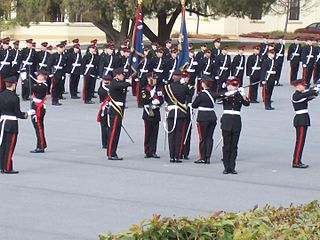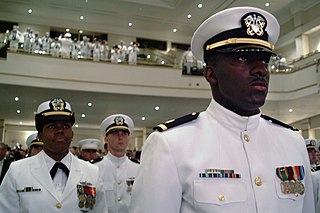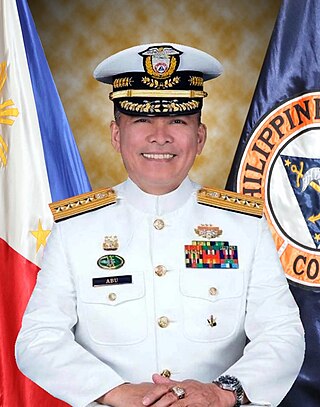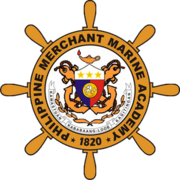
A military academy or service academy is an educational institution which prepares candidates for service in the officer corps. It normally provides education in a military environment, the exact definition depending on the country concerned.
A midshipman is an officer of the lowest rank in the Royal Navy, United States Navy, and many Commonwealth navies. Commonwealth countries which use the rank include Canada, Australia, Bangladesh, Namibia, New Zealand, South Africa, India, Pakistan, Singapore, Sri Lanka, and Kenya.

The United States Merchant Marine is an organization composed of United States civilian mariners and U.S. civilian and federally owned merchant vessels. Both the civilian mariners and the merchant vessels are managed by a combination of the government and private sectors, and engage in commerce or transportation of goods and services in and out of the navigable waters of the United States. The Merchant Marine primarily transports domestic and international cargo and passengers during peacetime, and operate and maintain deep-sea merchant ships, tugboats, towboats, ferries, dredges, excursion vessels, charter boats and other waterborne craft on the oceans, the Great Lakes, rivers, canals, harbors, and other waterways. In times of war, the Merchant Marine can be an auxiliary to the United States Navy, and can be called upon to deliver military personnel and materiel for the military.

The United States Coast Guard Academy (USCGA), located in New London, Connecticut, is the U.S. service academy specifically for the United States Coast Guard. Founded in 1876, the academy provides education to future Coast Guard officers in one of nine major fields of study.
The United States service academies, also known as United States military academies, are federal academies for the undergraduate education and training of commissioned officers for the United States Armed Forces.

The United States Merchant Marine Academy is a United States service academy in Kings Point, New York. It trains its midshipmen to serve as officers in the United States Merchant Marine, branches of the United States Armed Forces and the transportation industry. Midshipmen are trained in different fields such as marine engineering, navigation, ship's administration, maritime law, personnel management, international law, customs, and many other subjects important to the task of running a large ship.
A cadet is a student or trainee, and is typically used in military settings to denote an individual undergoing training to become commissioned officers. Several civilian organisations, including civil aviation groups, maritime organisations, and police services, also designate their trainees as cadets.
Texas A&M University at Galveston (TAMUG) is an ocean-oriented branch campus of Texas A&M University offering both undergraduate and graduate degrees. Students enrolled at Texas A&M University at Galveston, known affectionately as 'Sea Aggies', share the benefits of students attending Texas A&M University (TAMU) campus in College Station. TAMUG is located on Pelican Island, offering benefits for its maritime focused majors.
Officer candidate or officer aspirant (OA) is a rank in some militaries of the world that is an appointed position while a person is in training to become an officer. More often than not, an officer candidate was a civilian who applied to join the military directly as an officer. Officer candidates are, therefore, not considered of the same status as enlisted personnel.

The Naval Reserve Officer Training Corps (NROTC) program is a college-based, commissioned officer training program of the United States Navy and the United States Marine Corps.

The Philippine Navy (PN) is the naval warfare service branch of the Armed Forces of the Philippines. It has an estimated strength of 24,500 active service personnel, including the 10,300-strong Philippine Marine Corps. It operates 90 combat vessels, 14 auxiliary vessels, 25 manned aircraft and 8 unmanned aerial vehicles. Tracing its roots from the Philippine Revolutionary Navy on May 20, 1898, while its modern foundations were created during the creation of the Offshore Patrol in February 9, 1939, the PN is currently responsible for naval warfare operations and maritime patrol missions within the Philippine Waters, as well as ensuring the protection of the Philippine's maritime interests, including the West Philippine Sea and Benham Rise.

The Philippine Coast Guard (PCG) is the third armed uniformed service of the country attached to the Philippines' Department of Transportation, tasked primarily with enforcing laws within Philippine waters, conducting maritime security operations, safeguarding life and property at sea, and protecting marine environment and resources; similar to coast guard units around the world. In case of a declaration of war, the Coast Guard shall also serve as an attached service of the Department of National Defense.

The Australian Defence Force Academy (ADFA) is a tri-service military Academy that provides military and academic education for junior officers of the Australian Defence Force in the Royal Australian Navy (RAN), Australian Army and Royal Australian Air Force (RAAF). In 2016 the Academy began accepting civilian students in its undergraduate courses.

The Maritime Academy of Asia and the Pacific (MAAP) is a non-stock, non-profit maritime higher educational institution which is owned, developed and operated by the Associated Marine Officers' and Seamen's Union of the Philippines (AMOSUP). Its founding president, Capt. Gregorio S. Oca, alumnus of Philippine Nautical School headed the academy's board of governors, a group comprised by some of the organizations in the international maritime industry: the Filipino Association of Maritime Employers (FAME), the International Transport Workers’ Federation (ITF), the All Japan Seamen's Union, the Norwegian Seafarers’ Union (NSU), the International Maritime Employers Committee Limited (IMEC), the Danish Shipowners Association, the Norwegian Shipowners Association (NSA), Japanese Shipowners Association (JSA), and the International Mariners Management Association of Japan (IMMAJ). With their technical and financial support, the first MAAP campus opened in 1999.

PMI Colleges, formerly known as Philippine Maritime Institute, is a private, non-sectarian, co-educational higher education, Maritime institution established on September 18, 1948 in Santa Cruz, Manila, Philippines where its main campus is located.

The Philippine Military Academy also referred to by its acronym PMA is the premier military academy for Filipinos aspiring for a commission as a military officer of the Armed Forces of the Philippines (AFP). It was established on December 21, 1936, by the virtue of National Defense Act of 1935. It is patterned after the United States Military Academy, in West Point, New York. The academy is located in the city of Baguio, and serves as the primary training school for future officers of the AFP.
The California Maritime Academy Corps of Cadets is the undergraduate student body at the California Maritime Academy. As a State Maritime Academy, as required by Title 46 Part 310 of the Code of Federal Regulations students are considered Cadets, required to wear uniforms, and utilize a demerit-based disciplinary system. Participation in the Corps of Cadets is mandatory; participation in the Navy Reserve Merchant Marine program is optional. Cadets still utilize Merchant Marine Navy-style uniforms, customs, and traditions. Based on academic majors cadets are organized into Squads, Sections, Divisions and Companies which regularly muster in Morning Formations multiple times a week, as well as stand watches on campus and aboard the training ship.
Admiral Joel Sarsiban Garcia is a Philippine Coast Guard admiral who has served as the 28th Commandant of the Philippine Coast Guard, who also has served as the executive director of the National Coast Watch Center (NCWC), and the deputy commandant for administration of the Philippine Coast Guard
In the Philippines, Cadet is a rank held by candidate officer during the training to become commissioned officers in their preferred branch of military service.

Artemio Manalo Abu is a retired Filipino admiral who was the 29th commandant of the Philippine Coast Guard. As commandant, he was the overall commander of the entire Coast Guard units and commands, and is also responsible for all operations within the Philippines' maritime jurisdictions. Prior to his post, he served as the commander of the Maritime Safety Services Command and the Coast Guard Education and Training Command.
















